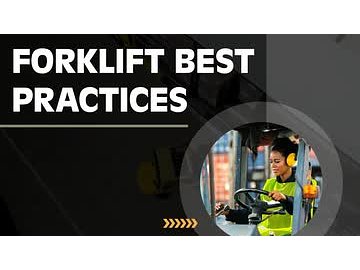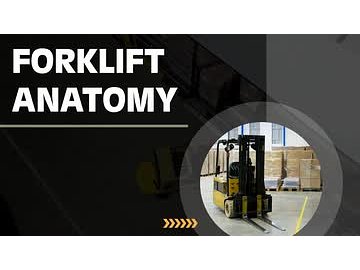Forklift Safety
German, English, Spanish, French, Portuguese, Thai, Chinese
30-Day Money Back Guarantee
Full Lifetime Access
Self-Paced
Finish in
67 mins!
Finish in
67 mins!
Made for for
Employees
only
Employees
only
Certificate
of Completion
of Completion
Mobile -
Friendly
Access
Friendly
Access
What you'll learn
Explain forklift stability using the
Explain how to calculate whether a forklift has the capacity to lift a given load
List key guidelines for maintaining a forklift's stability.
Description
Learners will demonstrate awareness of safe forklift operation principles by identifying basic key features on the lift, recognizing the technical components of forklift operation, listing safe load handling and driving practices, stating general safety rules, and inspecting and maintaining lift equipment.
System Requirements
• Windows 7 and newer
• Mac OS 10 and newer
Supported Browsers:
The current and previous major releases of the following browsers
• Safari v11 and higher
• Firefox v65 or higher
• Chrome v70 and higher
• Microsoft Edge v42 and higher
• Internet Explorer v11 and higher (Windows only- may exhibit visual differences from other
browsers)
Computer Speed and Processor:
• Use a computer 5 years old or newer when possible.
• 1GBofRAM
• 2GHz processor
Author
Making the Workplace Safer and Smarter
HSI (Health & Safety Institute) is a recognized leader in Environmental, Health and Safety (EHS) and workforce development software, training, and compliance solutions.
HSI is your single-source partner for EHS, Compliance, and Professional Development solutions. HSI provides integrated e-learning content, training solutions, and cloud-based software designed to enable your business to improve safety, operations, and employee development. Across all industries, we help safety and technical managers, human resources, first responders, and operational leaders train and develop their workforce, keep workers safe, and meet regulatory and operational compliance requirements. We are a unique partner that offers a suite of cloud-based software solutions including learning management, safety management, chemical SDS management, and more, integrated with our content and training so businesses can not only monitor and manage multiple workflows in one system, but train employees via one partner.
Forklift Safety

Forklift Best Practices
Forklift operation requires attention to your surroundings and adhering to safety protocols. This course explores essential best practices for operating forklifts in various challenging environments - from narrow aisles to loading docks and pedestrian areas. You'll learn techniques to maintain stability, manage your center of gravity, and adapt to different physical conditions, ensuring both efficient operations and compliance with OSHA regulations.

Forklift Best Practices: Physical Conditions
Your number one priority on the job, whether you're an employee or a manager, should be safety. In this course, we're going to talk about the various physical condition risks you may face while driving a forklift, and how to handle them. Physical conditions refer to the surface or ground conditions in your workplace. Potential hazards are typically divided into the following areas: slippery conditions, obstructions and uneven surfaces, and floor loading limits. We're going to go over the recommended ways to stay safe when you run into these hazards at work. This content complies with OSHA regulation 1910.178.

Forklift Best Practices: Safe Travel Practices
Your number one priority on the job, whether you're an employee or a manager, should be safety. In this course, we're going to cover safe travel practices. When you don't follow this type of safety protocol when operating a forklift, potential hazards include overturning the forklift, falling loads, being struck or crushed by the forklift, and collisions. This content complies with OSHA regulation 1910.178.

Forklift Best Practices: Ramps and Grades
Your number one priority on the job, whether you're an employee or a manager, should be safety. In this course, we're going to talk about ramps and grades. Tipover risk is increased on ramps and grades, so you need to follow the best practices that we're going to cover in order to stay safe. This includes turning, traveling with and without a load, when to use a spotter, and working with pallet trucks. This content complies with OSHA regulation 1910.178.

Forklift Best Practices: Tipovers and Loading Docks
Your number one priority on the job, whether you're an employee or a manager, should be safety. In this course, we're going to talk about tipovers, as well as the dangers of loading docks. We'll discuss the different types of tipovers and what to do if this happens to you, depending on the type of forklift you're using. We'll also go over what to do if you're working on or near loading docks. This content complies with OSHA regulation 1910.178.

Forklift Best Practices: Narrow Aisles and Enclosed and Hazardous Areas
Your number one priority on the job, whether you're an employee or a manager, should be safety. In this course, we're going to discuss the correct ways to handle narrow aisles and enclosed or hazardous areas according to the Occupational Health and Safety Administration (OSHA). We'll cover the best practices associated with the special trucks required, including reach trucks and order pickers. We'll talk about safe stacking rules, as well as the importance of air quality when working in an enclosed space with a forklift. This content complies with OSHA regulation 1910.178.

Forklift Safety: Introduction to Forklifts for Managers
Forklifts can be an incredible tool for workers, but they're also a tremendous safety hazard. Knowing the fronts, backs, ins and outs, upside downs and right side ups of forklifts is vital to doing your job effectively and, most importantly, safely. In this course, we'll cover forklift basics, including the types of forklifts, the power sources they use, and their parts, so you can ensure your employees stay safe. This content complies with OSHA regulation 1910.178.

Forklift Anatomy
Understanding a forklift's anatomy is essential for safe and efficient operation. This course explores different forklift classifications, power sources, and key components. You'll learn how each part functions, recognize critical safety features, and gain the knowledge needed to properly operate these powerful machines in compliance with OSHA requirements.

Forklift Safety: A Manager's Guide
As a manager, you're responsible for ensuring forklift operations remain safe, efficient, and compliant. This course examines the key responsibilities managers have under OSHA standard 1910.178, including operator training, regular evaluations, documentation, enforcing safe procedures, equipment maintenance, and fostering a safety culture. You'll learn proactive strategies to identify hazards before incidents occur and appropriate responses when accidents happen.

Forklift Operation Safety
Forklift accidents result in thousands of injuries annually, but most are preventable with proper safety protocols. This course covers essential operational safety practices for forklift operators, from pre-operation inspections to emergency response procedures. You'll learn proper load handling techniques, safe traveling practices, tipover prevention, and correct parking procedures-knowledge that helps protect both you and your coworkers while ensuring compliance with OSHA requirements.

Forklift Safety: Forklift Operations for Employees: Pre-Operation
There are three main stages of operation. Those stages are: Pre-Operation, Traveling and Maneuvering, and Load Handling. Right now we're going to start with the first stage: PreOperation. What you do before you operate a forklift is perhaps the most important part of the process. This is where you have the chance to identify anything that would make the forklift unsafe and to ensure the forklift isn't defective or in need of repair. If it is, it needs to be removed from service immediately, you'll need to document the problems, and report them to your supervisor. Let's go over what the inspection entails. This content complies with OSHA regulation 1910.178.

Forklift Safety: Forklift Operations for Employees: Load Handling
Operating a forklift is a big responsibility. If you don't follow safety guidelines and instructions, you could do major damage to the machinery, merchandise or, even worse, to yourself or fellow employees. The third stage of operating a forklift is load handling. There are eight steps for safe load handling, all of which have their own safe operating rules, and we'll go through each one in this course: 1. Safe handling preparation 2. Approaching 3. Mast position 4. Fork position 5. Lifting the load 6. Lowering the load 7. High tiering and 8. Loading and unloading trailers.






